Top 12 Isometric Exercises for Runners with Workout Example
If you are a beginner or an advanced runner who wants to include strength exercises into your workout routine, isometric exercises are a great choice for you.
In this article, you will learn what are isometric exercises, find examples of exercises and workouts for runners, as well as the reasons why you should include them in your training plan.
What are isometric exercises?
Isometric exercises are strength exercises during which the length of the muscle and the angle of the joint do not change. They are performed in a static position and require muscle tension without the use of movement. They develop strength, prevent injury, and are used for rehabilitation.
Info
The term “Isometrics” comes from the combination of two Greek words, ISO (equal) and METRIA (measure), which means that in these exercises the length of the muscle and the angle of the joint does not change, even though muscle contraction may vary significantly.
Below, I will show you 12 isometric exercises for runners that you can include in your strength training routine and one example of an isometric workout.
Isometric exercises for runners
Isometric exercises will improve your strength so that, afterward, you can perform more dynamic and explosive exercises properly.
While performing each exercise, it is important to focus on proper form.
If you aren’t able to do an exercise properly, shorten the duration of the exercise and increase the duration of recovery.
Also, focus on breathing. It is important to breathe during the whole exercise to ensure proper oxygen flow.
1. Plank
This exercise activates your core, glutes, quadriceps, and shoulders.
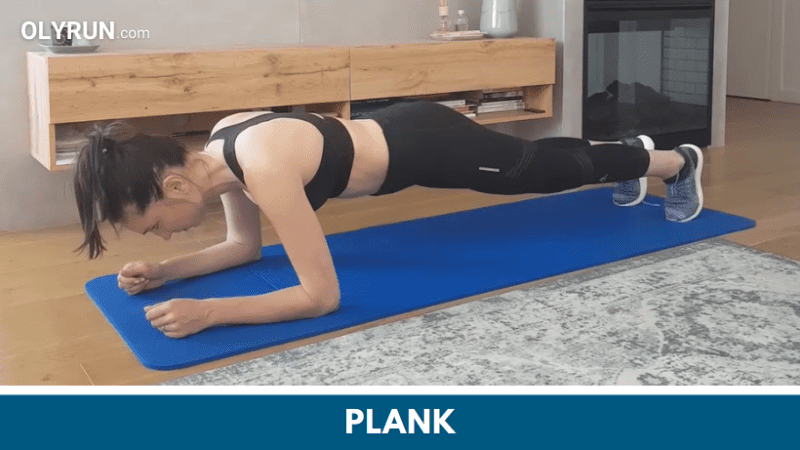
How to properly do a plank?
- Get into the starting position, face down with your elbows and toes on the floor. Your feet are hip-width apart. The elbows are perpendicular to the floor and are right below your shoulders, with the forearms facing forward. Your head, neck, and spine are straight, and you are looking down at the floor.
- Tighten your muscles and hold this position for about 30–60 seconds.
Advice for doing a plank
- Check your posture – keep your spine neutral, and don’t drop your hips or stick your butt in the air.
- Don’t bend your back – if you bend your back, you do not engage your abdominal muscles well enough and you put greater pressure on your arms.
- For an easier version of this exercise, rest on your knees instead of your feet.
2. High plank
This exercise activates your core, glutes, quadriceps, shoulders, and arms.
How to properly do a high plank?
- Start in a push-up position, face down with your palms and toes on the floor. Your feet are hip-width apart. The arms are outstretched and perpendicular to the floor and right below your shoulders. Your head, neck, and spine are straight, and you are looking down at the floor.
- Tighten your muscles and hold this position for about 30–60 seconds.
Advice for doing a high plank
- Check your posture – keep your spine neutral, and don’t drop your hips or stick your butt in the air.
- Don’t bend your back – if you bend your back. You do not engage your abdominal muscles well enough, and you put greater pressure on your arms.
- For an easier version of this exercise, rest on your knees instead of your feet.
3. Side plank
This exercise activates your core, glutes, quadriceps, shoulders, arms, and lower back muscles.
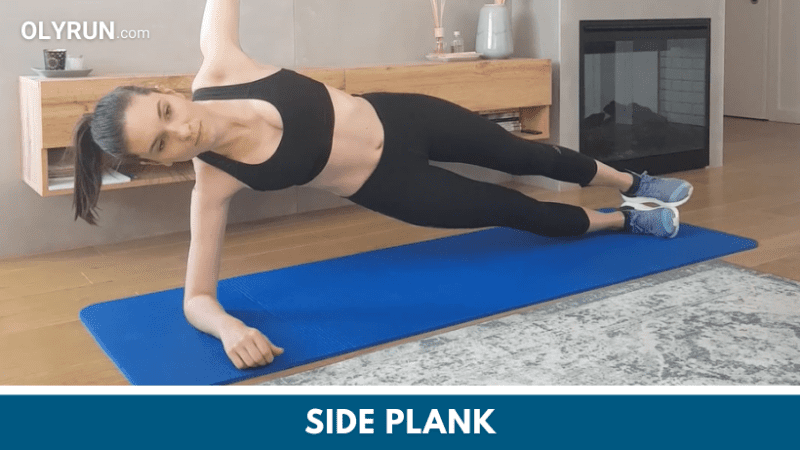
How to properly do a side plank?
- Get into the starting position, with the right forearm and the side of your right foot on the floor. Elbow is perpendicular to the surface and right below your shoulder. Your head, neck, and spine are straight, and you are looking straight ahead.
- Tighten your muscles and hold this position for about 30–60 seconds.
- Repeat the exercise on the other side.
Advice for doing a side plank
- Check your posture – don’t lift or lower your hips and avoid twisting your body.
- For a more difficult version of this exercise, rest on your palm instead of your forearm.
4. Reverse plank
This exercise activates your core, glutes, hamstrings, and shoulders.
How to properly do a reverse plank?
- Get into the starting position, face up with your forearms and heels on the floor. Your feet are hip-width apart. The elbows are perpendicular to the surface and right below the shoulder. Your head, neck, and spine are straight, and you are looking up.
- Tighten your muscles and hold this position for about 30–60 seconds.
Advice for doing a reverse plank
- Check your posture – keep your spine neutral, and don’t drop your hips.
- For a more difficult version of this exercise, rest on the heel of only a single foot, lifting the other one off the floor.
5. Superman
This exercise activates your glutes, core, shoulders, arms, and upper back muscles.
How to properly do the superman exercise?
- Get into the starting position, lying on your stomach, face down with arms outstretched and legs aligned with your hips. Your head, neck, and spine are straight, and you are looking down at the floor.
- Lift your outstretched arms and legs off the floor and hold this position for about 30–60 seconds.
Advice for doing the superman exercise
- Check your posture – don’t let your arms and legs touch the floor.
- Don’t bend your arms and legs – arms and legs must be outstretched.
- Don’t forget to breathe – although you’re facing the floor, it is important to breathe during the whole exercise to ensure proper oxygen flow to the muscles.
6. Alternating superman
This exercise activates your glutes, core, shoulders, arms, and upper back.
How to properly do the alternating superman exercise?
- Get into the starting position, lying on your stomach, face down with arms outstretched and legs aligned with your hips. Your head, neck, and spine are straight, and you are looking down at the floor.
- Lift your outstretched left arm and right leg off the floor and hold this position for about 30–60 seconds.
- Repeat the exercise on the other side.
Advice for doing the alternating superman exercise
- Check your posture – don’t let your arms and legs touch the floor.
- Don’t bend your arms and legs – arms and legs must be outstretched.
- Don’t forget to breathe – although you’re facing the floor, it is important to breathe during the whole exercise to ensure proper oxygen flow to the muscles.
7. Bridge on heels
This exercise activates your core, glutes, and hamstrings.
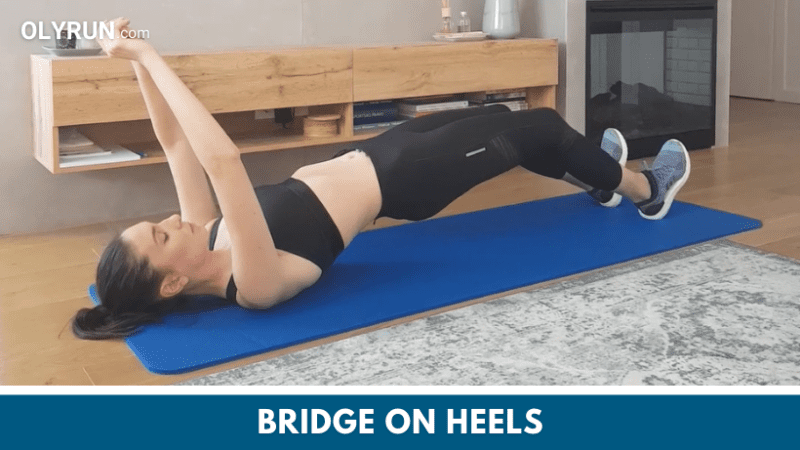
How to properly do the bridge on heels exercise?
- Get into the starting position, face up with shoulders and heels on the floor. Legs are slightly bent at the knee and are hip-width apart. You are looking up.
- Tighten your muscles and hold this position for about 30–60 seconds.
Advice for doing the bridge on heels exercise
- Check your posture – don’t drop your hips.
- For a more difficult version of this exercise, rest on the heel of only a single foot, lifting the other one off the floor.
8. Bridge
This exercise activates your core, glutes, and hamstrings.
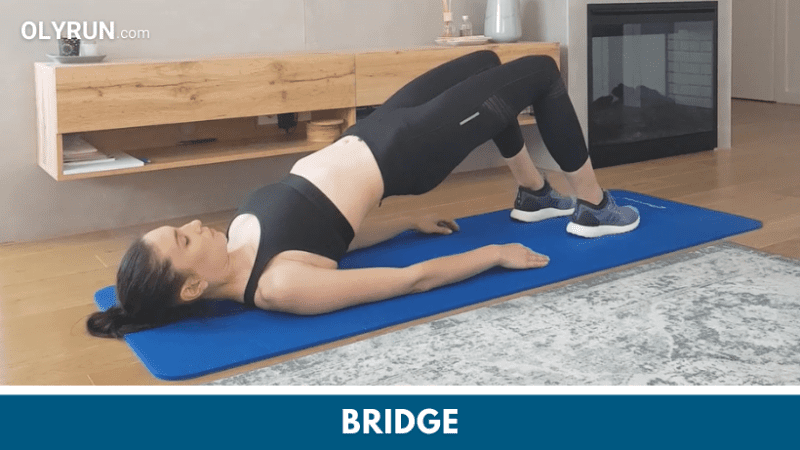
How to properly do the bridge exercise?
- Get into the starting position, face up with shoulders and feet on the floor. Legs are slightly bent at the knee at right angles and are hip-width apart. You are looking up.
- Tighten your muscles and hold this position for about 30–60 seconds.
Advice for doing the bridge exercise
- Check your form – don’t drop your hips.
- For a more difficult version of this exercise, add weight onto your hips or use a resistance band.
9. Single leg bridge
This exercise activates your core, glutes, and hamstrings.
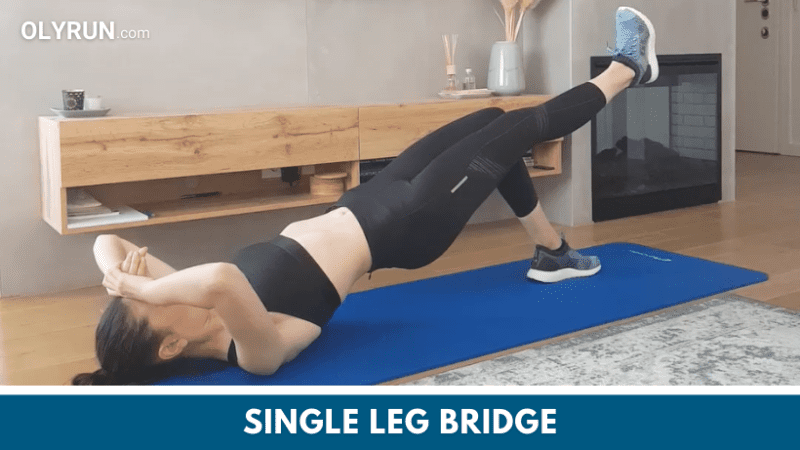
How to properly do the single leg bridge exercise?
- Get into the starting position, face up with your shoulders, and your left foot on the floor. The left foot is bent at the knee at a right angle, while the right leg is outstretched and aligned with your spine. Both feet are hip-width apart. You are looking up.
- Tighten your muscles and hold this position for about 30–60 seconds.
- Repeat the exercise on the other side.
Advice for doing the single leg bridge exercise
- Check your posture – don’t drop your hips and avoid twisting your body.
- For a more difficult version of this exercise, add weight onto your hips or use a resistance band.
10. Isometric bird dog
This exercise activates your glutes, core, shoulders, arms, and upper back.
How to properly do the isometric bird dog exercise?
- Get into the starting position, on your knees with palms on the floor, looking down. Arms are outstretched. Your head, neck, and spine are straight, and you are looking down at the floor.
- Lift your outstretched left arm and right leg so that your spine is aligned and hold this position for about 30–60 seconds.
- Repeat the exercise on the other side.
Advice for doing the isometric bird dog exercise
- Do not bend your arms and legs – the lifted arm and leg must be outstretched.
- Don’t forget to breathe – although you’re facing the floor, it is important to breathe during the whole exercise to ensure proper oxygen flow to the muscles.
11. Wall sit
This exercise activates your glutes, quadriceps, and hamstrings.
How to properly do the wall sit exercise?
- Get into the starting position, sitting next to a wall so that your legs are bent at the knee at a right angle, with your whole back resting on the wall. Legs are slightly apart and the whole foot is on the floor.
- Tighten your muscles and hold this position for about 30–60 seconds.
Advice for doing the wall sit exercise
- Check your posture – your thighs must be parallel to the surface.
- Don’t forget to breathe – it is extremely important to breathe during the whole exercise to ensure proper oxygen flow to the muscles.
- Do not get up on your toes – the whole foot must be on the floor.
12. Calf raise hold
This exercise activates your calf muscles.
How to properly do the calf raise hold exercise?
- Get into the starting position, standing on your feet pointing forward. Your feet are hip-width apart, and your legs are outstretched. Your head, neck, and spine are straight, and you are looking straight ahead.
- Lift the front of your foot, tighten your muscles, and hold this position for around 30–60 seconds.
Advice for doing the calf raise hold exercise
- If you find it hard to keep your balance, feel free to hold on to a tree, wall, or pole.
- Don’t bend your legs at the knees – legs must be outstretched during the whole exercise.
- For a more difficult version of this exercise, add some weights.
An example of an isometric workout for runners
This workout consists of 5 exercises.
You can do it anywhere, without the need for any additional equipment, and it is great for beginners and advanced runners.
Exercise overview
- Plank
- Bridge on heels
- Side plank
- Bridge
- Single leg bridge
Required equipment
For this workout, you will need a stopwatch a timer, and an exercise mat.
If you want to make the workout more difficult, you will also need dumbbells or a resistance band.
Instructions on how to perform exercises
- Before starting your workout, do a warm-up routine for at least 5 to 10 minutes. This should include dynamic stretching and mobility exercises.
- Perform each exercise for 30 to 60 seconds, resting between each exercise as short as possible.
- Check your form during every exercise. If you aren’t able to do an exercise properly, shorten the duration of the exercise, and increase the duration of recovery.
- After you finish all five exercises, rest 30–60 seconds between sets, depending on your current fitness level and the time you have available. After that, repeat the whole set.
- If you are a beginner, do one or two sets, and if you are an advanced runner, do three or four sets.

Benefits of isometric exercises for runners
Alongside dynamic strength exercises, runners also do isometric exercises because of their numerous benefits.
1. They build strength
Research has shown that isometric exercises increase muscle strength and tone your muscles faster than dynamic exercises.
2. They strengthen your core
A stable core is crucial for proper running technique. If the core is too weak, your body will not be able to control your movements.
The strong core ensures the transmission of force gained from swinging your arms onto your legs, making you run more efficiently.
3. They activate a significantly larger number of muscle fibers
Isometric exercises activate a larger number of muscle fibers compared to dynamic strength exercises.
Research has shown that isometric exercises recruit up to 5% more motor units than any other type of exercise.
In other words, isometric exercises activate around 95% of your muscles, compared to other exercises that activate around 88–90%.
4. They improve stability
In addition to surface muscles, isometric exercises also activate deep muscles, that is, the muscles around the spine.
Together, they strengthen and support the spine, improving stability, as well as the health and function of your joints.
5. They improve muscular endurance
Isometric training improves muscle’s ability to generate strength over a longer period of time and has a positive effect on performance in exercises that require endurance.
6. You can do a great workout in a short period of time
Research has shown that 6 minutes of isometric exercises are equal to 30 to 35 minutes of exercise on weightlifting equipment in a gym.
7. They are used for rehabilitation
They are great for those who are recovering from an injury.
They allow them to strengthen their muscles and maintain their muscle tone without quick and painful movements or burdening the joints.
8. They help you control your breathing
When doing isometric exercises, it is important to control your breathing.
Proper breathing during training also helps apply proper breathing in your daily life, which helps improve your posture and reduce stress.
9. They are adjustable
There are lots of versions of these exercises, easier or more difficult versions, meaning that they can be adjusted to each individual, regardless of their fitness level.
10. They are meant for everyone
Isometric exercises are great both for beginners and advanced runners.
11. You don’t need any equipment
All you need is your body weight, and for the additional load, you can use any suitable object, such as a water bottle.
You do not need any special workout equipment or additional space, so there is no need for expensive gym memberships.
12. You can do them anywhere
Since you don’t need any special equipment for doing isometric exercises, you can do them in a gym, at home, or in a park.
Disadvantages of isometric exercises for runners
Alongside the numerous benefits of isometric exercises, there are also a couple of disadvantages.
1. The increase in muscle strength is limited to specific muscle groups
Since isometric exercises are done in a single position, without movement, you will increase strength only in one specific position.
In order to improve muscle strength throughout a whole range of motions, you would have to do various isometric exercises throughout a whole range of motions.
They are monotonous
Isometric exercises are static, and runners often find it hard to stay motivated for this kind of strength training.
Do isometric exercises make you faster?
Isometric exercises activate fast-twitch muscle fibers, resulting in increased speed.
During low-intensity runs over long distances, slow-twitch muscle fibers are activated. Isometric exercises are well known for their ability to activate 95% of the muscle groups, which is a great way to activate fast-twitch muscle fibers as well.
Research has shown that athletes’ performance after isometrics and plyometrics is comparable but without damage to joints and ligaments.
Likewise, isometric exercises strengthen stabilizer muscles, which help maintain proper form during running. The longer you are able to maintain proper running form, the more efficiently you will run and, with it, the faster you will be.
Therefore, if you want to improve your running speed, include isometric training in your training plan.
Can I just do isometrics, and skip my strength training workout?
It is best to combine isometric exercises with other strength exercises since isometric exercises improve strength only in one specific position.
In order to improve muscle strength throughout a whole range of motions, you would have to do various isometric exercises throughout a whole range of motions.
Read more: Strength Training for Runners (Top 19 Workout Exercises)
How often should you do isometric exercises?
You can do isometric exercises every day, and you should do them at least two times a week if you want to see any results.
It is very easy to include them into your daily routine since they are short and can be done anywhere, and because you don’t need any additional equipment for them.
Research has shown that doing isometric exercises over the course of 2 or 3 weeks can produce a significant increase in isometric muscle strength.
For maximum results, do not neglect other strength exercises.

Matea Matošević
Hi, I’m Matea! I’m an Olympic Marathon Runner, founder, and writer behind OLYRUN.com. On this site, I provide help in the form of my knowledge and experience to all who love running and active living. Read more…

